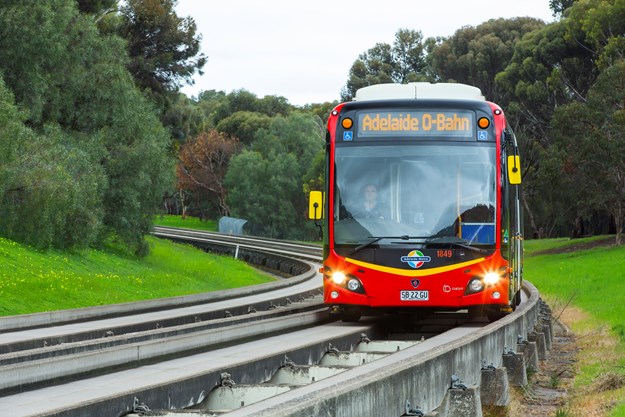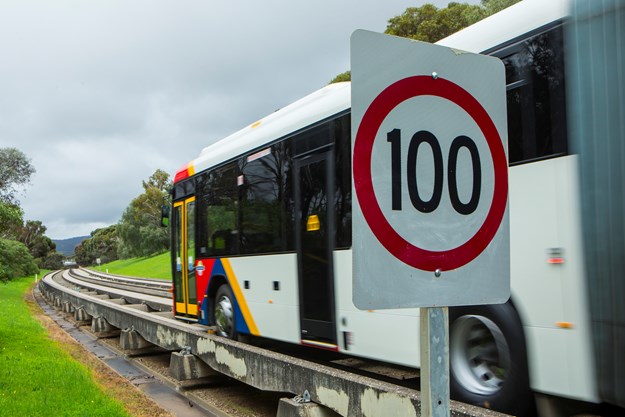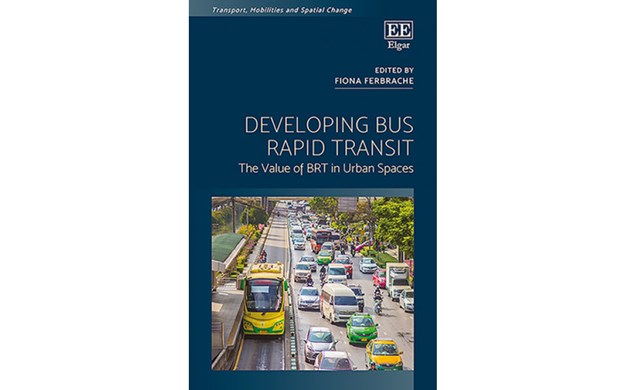AFTER 34 YEARS of service, Adelaide’s German-inspired O-Bahn guided bus system is “far more efficient than city’s rail network”, according to experts cited in an official academic paper released recently.
At the time it was “a giant leap of faith”, but ever since the Adelaide O-Bahn rolled out its first guided bus from the CBD to the north-eastern suburb of Paradise, it has answered its doubters, says the University of South Australia.
First flagged in 1979 by the incoming Liberal Government – which shelved Don Dunstan’s plans for a light-rail transit line along the River Torrens corridor to service the growing north-eastern suburbs – on paper the O-Bahn stacked up. It was less costly than light rail; the track was narrower, reducing the environmental impact; it offered flexibility, allowing buses to enter and exit from the road system; and it promised a faster, quieter and more reliable ride than other transport options, it explains.
It was also the first guided busway in the southern hemisphere.
More than three decades later, a new paper co-authored by University of South Australia Adjunct Professor Derek Scrafton, a former Director-General of Transport in South Australia during the O-Bahn’s construction, provides an insight into the guided busway’s history and the lessons learned.
INCREASING POPULARITY
Prof Scrafton, one of Australia’s foremost urban planning experts, according to university, says around 31,000 passenger trips are made each weekday on the O-Bahn.
“The O-Bahn is far more efficient than Adelaide’s rail network, in terms of patronage per kilometre,” Scrafton said.
“Its popularity is also increasing each year, with 50 per cent more people using it than in the early 1990s,” he explained.
Until 2011, it was the longest full-scale operational guided busway in the world, taking passengers the 15 kilometres from Tea Tree Plaza, via Paradise and Klemzig, to the city centre in under 20 minutes, it states. The park-and-ride concept provides around 2000 car spaces in total across the three interchanges, easing traffic congestion in the burgeoning north-east corridor, says the university.
“It is nowhere near its capacity, either,” added Scrafton.
“It could conceivably carry 18,000 passengers an hour in each direction with the use of articulated buses.
“The only constraint to the existing system is the availability of kerb space in the CBD for bus stops, picking up and delivering people to their destination.”
FUTURE EXPANSION
A bonus has been the development of the River Torrens Linear Park alongside the O-Bahn, transforming a rundown urban drain into a picturesque open space with 150,000 trees, plants and shrubs, and a cycle/walkway for thousands of commuters and recreational cyclists, says the university.
Now, given its success and popularity, the question many are asking, according to the university statement, is: why hasn’t it been ‘replicated’ in Adelaide?
Scrafton says in 2000 the then Labor Government, under John Bannon, assessed the feasibility of extending the O-Bahn to serve the southern corridor.
“Despite a clear economic case mounted for it, the bias to rail led to no further action and instead the main train lines were electrified,” he explained.
A controversial AUD$168 million extension of the guideway from Gilberton to the CBD via a tunnel under the parklands was completed in 2017, reducing travel time by four minutes.
“There was a lot of opposition to the extension – mainly due to the cost and environmental disruption – but the long-term objectives are sound: to clear congestion on the arterial roads and improve conditions for the remaining traffic,” Scrafton said.
“The extension has benefitted both motorists and bus commuters, as well as improving conditions for cyclists and pedestrians.”
LAND ISSUE
More recently, a major transport study has recommended the O-Bahn be extended to Golden Grove, but the proposal is yet to be discussed in Parliament. It would require the acquisition of extensive tracts of private property, a major hurdle, the university says.
Scrafton and his co-author, Professor David Bray, from the University of Queensland, have published their analysis of Adelaide’s O-Bahn in a chapter of the book Developing Bus Rapid Transit: The Value of BRT in Urban Spaces. It compares bus rapid transit systems around the world.
BUS PRIORITY
When asked about the paper’s findings, a spokesperson for Bus SA, Lauran Huefner, said: “O-Bahn was and is clearly a smart investment; it’s quick and effective and travellers have spoken with their feet.”
“It remains a bus rapid transit trailblazer and Bus SA would love to see more of it in Adelaide – whether in the form of simple bus-priority measures, like lights or priority lanes, or more complex infrastructure that makes it easier for people to move around.”
Julian Gurney, director of Sales for Scania Australia Buses and Engines, said:”Scania has been a keen supporter of the O-Bahn concept having supplied almost 170 O-Bahn compatible buses to date. These have been a mix of rigid and articulated units.”
“As a supplier of low-emission and alternative-fuel buses around the world and committed to bus rapid transit concepts, Scania has the capacity to deliver to the O-Bahn future buses that deliver low or zero emissions through existing hybrid or future electric buses, further enhancing the environmental benefits of this mass transit system to the citizens of Adelaide,” he said.
ABOUT THE AUTHORS
Professor Derek Scrafton is an Adjunct Professor of the School of Natural and Built Environments at the University of South Australia. He was Director-General of Transport for South Australia during the construction of the O-Bahn, from 1979-1988.
Scrafton co-authored a chapter in this book called The Adelaide O-Bahn: evolution, operation and lessons. The book features the best examples of bus rapid transit systems around the world.
Professor David Bray was a consultant economist and engineer on the O-Bahn project.
Photography: courtesy Scania Australia



.jpg)


.png)



.jpg)
